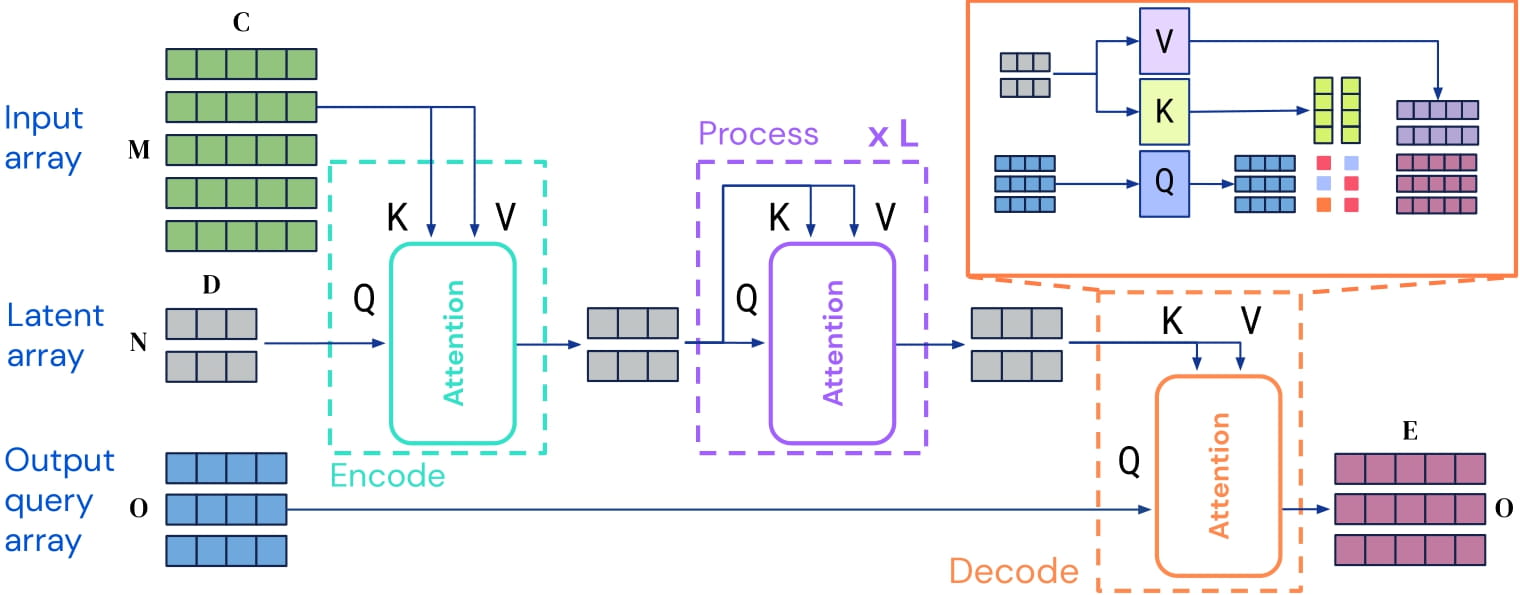Perceiver IO for vision (convolutional processing)
Perceiver IO model pre-trained on ImageNet (14 million images, 1,000 classes) at resolution 224x224. It was introduced in the paper Perceiver IO: A General Architecture for Structured Inputs & Outputs by Jaegle et al. and first released in this repository.
Disclaimer: The team releasing Perceiver IO did not write a model card for this model so this model card has been written by the Hugging Face team.
Model description
Perceiver IO is a transformer encoder model that can be applied on any modality (text, images, audio, video, ...). The core idea is to employ the self-attention mechanism on a not-too-large set of latent vectors (e.g. 256 or 512), and only use the inputs to perform cross-attention with the latents. This allows for the time and memory requirements of the self-attention mechanism to not depend on the size of the inputs.
To decode, the authors employ so-called decoder queries, which allow to flexibly decode the final hidden states of the latents to produce outputs of arbitrary size and semantics. For image classification, the output is a tensor containing the logits, of shape (batch_size, num_labels).

Perceiver IO architecture.
As the time and memory requirements of the self-attention mechanism don't depend on the size of the inputs, the Perceiver IO authors can train the model directly on raw pixel values, rather than on patches as is done in ViT. This particular model employs a simple 2D conv+maxpool preprocessing network on the pixel values, before using the inputs for cross-attention with the latents.
By pre-training the model, it learns an inner representation of images that can then be used to extract features useful for downstream tasks: if you have a dataset of labeled images for instance, you can train a standard classifier by replacing the classification decoder.
Intended uses & limitations
You can use the raw model for image classification. See the model hub to look for other fine-tuned versions on a task that may interest you.
How to use
Here is how to use this model in PyTorch:
from transformers import PerceiverFeatureExtractor, PerceiverForImageClassificationConvProcessing
import requests
from PIL import Image
feature_extractor = PerceiverFeatureExtractor.from_pretrained("deepmind/vision-perceiver-conv")
model = PerceiverForImageClassificationConvProcessing.from_pretrained("deepmind/vision-perceiver-conv")
url = "http://images.cocodataset.org/val2017/000000039769.jpg"
image = Image.open(requests.get(url, stream=True).raw)
# prepare input
inputs = feature_extractor(image, return_tensors="pt").pixel_values
# forward pass
outputs = model(inputs)
logits = outputs.logits
print("Predicted class:", model.config.id2label[logits.argmax(-1).item()])
>>> should print Predicted class: tabby, tabby cat
Training data
This model was pretrained on ImageNet, a dataset consisting of 14 million images and 1k classes.
Training procedure
Preprocessing
Images are center cropped and resized to a resolution of 224x224 and normalized across the RGB channels. Note that data augmentation was used during pre-training, as explained in Appendix H of the paper.
Pretraining
Hyperparameter details can be found in Appendix H of the paper.
Evaluation results
This model is able to achieve a top-1 accuracy of 82.1 on ImageNet-1k.
BibTeX entry and citation info
@article{DBLP:journals/corr/abs-2107-14795,
author = {Andrew Jaegle and
Sebastian Borgeaud and
Jean{-}Baptiste Alayrac and
Carl Doersch and
Catalin Ionescu and
David Ding and
Skanda Koppula and
Daniel Zoran and
Andrew Brock and
Evan Shelhamer and
Olivier J. H{\'{e}}naff and
Matthew M. Botvinick and
Andrew Zisserman and
Oriol Vinyals and
Jo{\~{a}}o Carreira},
title = {Perceiver {IO:} {A} General Architecture for Structured Inputs {\&}
Outputs},
journal = {CoRR},
volume = {abs/2107.14795},
year = {2021},
url = {https://arxiv.org/abs/2107.14795},
eprinttype = {arXiv},
eprint = {2107.14795},
timestamp = {Tue, 03 Aug 2021 14:53:34 +0200},
biburl = {https://dblp.org/rec/journals/corr/abs-2107-14795.bib},
bibsource = {dblp computer science bibliography, https://dblp.org}
}
- Downloads last month
- 1,240